#Here you go fishblr
Text



Mackerel patches are heeeere! I'm so so pleased with how these came out.
shop
#solarpunk#artists on tumblr#printmaking#punk#patches#punk patches#blockprinting#diy fashion#diy punk#eco-fashion#solarpunk fashion#fish#fishblr#is a thing apparently?#Here you go fishblr#mackerel#nature art#small business#folk punk#goblincore#sew on patch
176 notes
·
View notes
Text

This is the devil’s hole pupfish! A tiny species that lives only in One water-filled limestone cavern in Nevada. It was one of the first animals on the endangered species list. At the last count in 2022 there were 263 pupfish observed - the most in 19 years! They’re tracked pretty carefully, as their 215 square foot habitat (the smallest of any know vertebrate) is fragile and has been disturbed in the past by groundwater extraction and other human interference.
[ID: an illustration of a shiny metallic blue fish, the male devil’s hole pupfish, facing to the right. It is on a lighter blue background with a ripple pattern. End.] l
#fish#fishes#fishblr#devils hole pupfish#icthyology#they were apparently controversial little guys in the 70s bc a family bought the land they’re on and tried to build a bunch of wells#and some agencies were like hey don’t build those here there are these pupfish#and I guess they went to court and it was a whole publicized thing and folks were getting bumper stickers that said either#save the pupfish or kill the pupfish#and the concept of being so self absorbed that you’re like I would rather a species go extinct forever than for one human family to have#wasted some money#and I’m gonna get a bumper sticker that informs you of this#is so fucking funny to me
720 notes
·
View notes
Text
I hope he rests in peace.
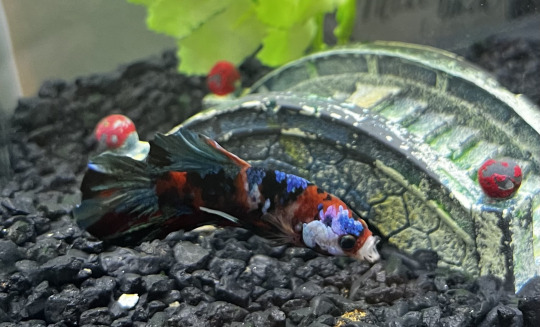
This was my galaxy koi betta fish. He passed sometime in the last 24 hours. I hope he had a good life.
#i really wanted to tell someone but didn't really have anyone#so here you go tumblr#his name was Andromeda btw#i hope you guys love him as much as I did#rip fishie#betta fish#betta#fishblr
56 notes
·
View notes
Text
#fish#fishblr#meet charlie! pointy baby of 4 years#videos take a ridiculous amount of space on my phone so like here you go you get my dear friend#she was obsessed with this side of her tank
3 notes
·
View notes
Text
What Is and Isn't a Fish: an Essay and Guide by Fishyfishyfishtimes
A simplified list of the animals I discuss can be found here!
Hello folks! I created this post to have a kind of definitive essay/explanation of what is and isn't a "fish", starting with defining the term and going over animals that fit and don't fit the bill. As other fishblr artists, writers and educators must know too well, some people are confused about where this term begins and ends, mistaking other aquatic animals for fish. I have my fair share of arthropods and cnidarians as fish fact requests in my own askbox, heck, some years back a friend of mine asked me if clams were fish. The event that finally made me decide to write this was someone requesting that a fish-only account draw a crustacean, pondering to themselves if they count as fish.
I don't want to hold it against these people. It's impossible to know something when you've never been taught! So that's what I'm here to do, hopefully achieving a pretty correct and universal view ^^' If I make any mistakes please correct me. I'm learning all the same as everyone else is.
Definition of fish
Immediately, we run into a bit of a problem with the definition of fish. See, what the term "fish" means has fluctuated for centuries! For a long time, pretty much any animal that lived in water was a "fish" — I say "pretty much any" instead of "every" animal because for a long time sessile animals like sponges or corals were thought to be plants. This is why we have such remnants in our language like shellFISH, starFISH and jellyFISH, they lived in water so they were called such!
Occasionally these definitions would be changed for cultural convenience too. Many Christian churches take part in Lent, and in the Catholic church red and white meat is forbidden on Fridays and Ash Wednesday. In the Middle Ages, in my own country, Finland, this abstinence of red and white meat could last up to 140 days! To make fasting easier, many animals were labelled fish for convenience so they could be eaten as well. These newfound "fish" included seals, beavers and swans, pretty much just anything that was aquatic or semiaquatic in nature.
Nowadays just going off of looks or behaviour won't do, though. There has been much more of an effort to define fishes coherently based on their anatomy and phylogeny, which is great! Problem is, that's easier said than done: fishes are an extremely diverse group, and uh.. not really a single group, either. I'll show you:

As you can see from this heavily simplified phylogenic tree, fishes are not a singular group like, say, mammals are! The animals that we group under "fish" are actually a part of several distinct lineages of animals, some more closely related to us than each other. Heck, tetrapods, which include amphibians, reptiles*, and mammals, are fish themselves! Phylogenetically speaking. Our ancestors were lobe-finned fish, and, well, you never stop being the previous taxon even when you evolve into something else. If you try to exclude tetrapods, no such unified group as "fish" exists. Still, when discussing fish, we tend to want to avoid talking about every vertebrate ever and instead focus on the very specific aquatic ones we mean when we say "fish". This is why many definitions of the term "fish" still exclude tetrapods, even if we share a common fishy ancestor. "Fish" describes more of a lifeform than it does a clade, much like the term "worm"!
(*birds are reptiles! This could be a whole post in and of itself, but I'm not here to write about that. Someone else has most likely taken up the task!)
Hooray, it's definition time! As stated previously, fishes are an extremely diverse group of thousands of species, and what terms might apply to the Atlantic cod may not apply to the yellowfin tuna or giant mudskipper, let alone a Pacific lamprey! Encyclopedia.com defines a fish as "an ectothermic chordate that lives primarily in water and possesses a cranium*, gills that are useful virtually throughout life, and appendages (if present) in the form of fins". Encyclopedia Britannica notes that "the term fish is applied to a variety of vertebrates of several evolutionary lines", instead highlighting five classes. These five classes are left partly unspecified, but ones that are mentioned are jawless fish, cartilaginous fish and bony fish (which still includes tetrapods, however), and the two classes left can be assumed to be two classes of extinct fish. Wikipedia defines a fish as "an aquatic, craniate**, gill-bearing animal that lacks limbs with digits". Tim M. Berra, an academy professor and ichtyologist, defines fish as "poikilothermic***, aquatic chordate with appendages (when present) developed as fins, whose chief respiratory organs are gills and whose body is usually covered with scales".
(*cranium=upper part of the skull **craniate=an animal with a skull ***poikilothermic=an animal whose internal temperature varies considerably)
From these more or less detailed definitions we can gather many defining features for fish: a cranium-having chordate, primarily aquatic, gill-bearing and uses gills as their main respiratory organ, lacking any limbs with digits, instead having their limbs be in paired and unpaired fins when present. Most fish are also ectothermic, meaning their body temperature is determined by their environment, but some can heat up parts of their body or their entire body in the case of the opah. Most fish also have scales, but not all, just like how most fish are fully aquatic, but some like lungfish or mudskippers can spend considerable time out of the water. Such is the way of these magnificent and diverse animals!
Finally, with all this out of the way, we can get into...
What is a fish!
Here, I will be detailing animals that are fish! Well, at least the broadest strokes; there are more than 30 000 fish species and if I listed them all we'd be here all life. I shall instead go over the major classes and list, in short, some groups that belong in them.
Jawless fish (Superclass Cyclostomi)
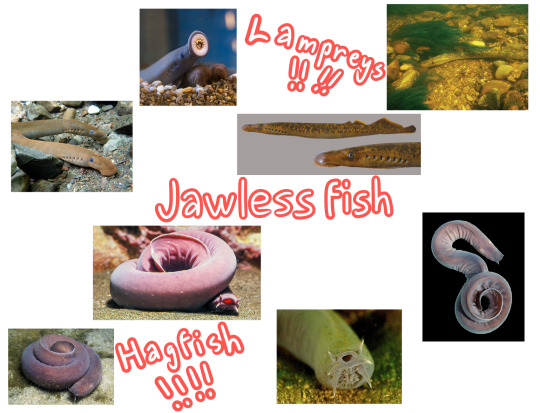
Jawless fish are often a topic of debate, especially in matters of their relation to each other and to jawed vertebrates. Evidence seems to point to hagfish and lampreys being closest related to one another and to lampreys being more closely related to jawed vertebrates than to hagfish (which would make hagfish craniates but not vertebrates). In the phylogeny tree above I decided to portray hagfish and lampreys as a monophyletic group, as molecular studies and microRNA analysis seems to point to a monophylegic superclass. Please note that this could go either way, though.
Jawless fish is a group containing two extant fishes, hagfish (class Myxini) and lampreys (order Petromyzontiformes)! Jawless fish are more "primitive" than other groups, for example both lack true vertebrae and scales. Still, they both have craniums and gills and they are aquatic, and so they have earned their place among fish!
Cartilaginous fish (class Chondrichthyes)
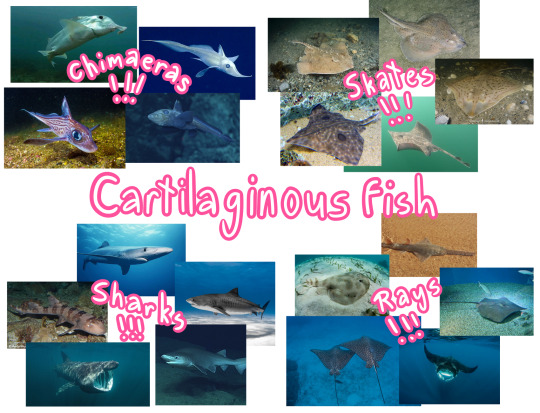
Surprisingly, I've found that this group has a lot of confusion surrounding it. I have received many a request confirming if sharks are fish, or asking if I'd cover a shark "even if it's not a fish". So I'll say it now: good news, sharks are indeed fish! So are their cousins, rays, skates and chimaeras, also known as ghost sharks! All of these fish have a primarily cartilaginous skeleton, tooth-like dermal denticles and lack gill covers and a swim bladder. Out of all the sharks, I also want to highlight that the whale shark, despite its confusing name, is a shark and not a whale. So, it is a fish!
Ray-finned fish (class Actinopterygii)
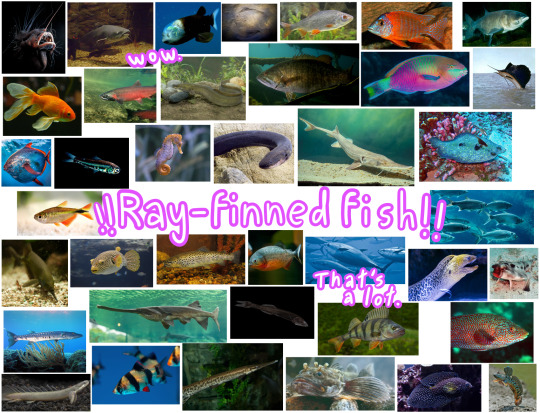
Name any fish, and there's a 96% chance the species name you said belongs to a ray-finned fish. Unless, like, you really like sharks. But this isn't about them.
Ray-finned fish are the biggest group of fish and incredibly diverse! It has your seahorse, your pufferfish, your bass, your tuna, your anglerfish, your clownfish, your salmon, your sturgeon, your lanternfish, your perch, your oarfish, your gar, your sardine, your moray eel... and this is only a tiny, tiny fraction of the groups that belong to this class! Defining features of ray-finned fish are that they tend to have a swim bladder and a bony skeleton (some exceptions though. Sturgeons, for one, have evolved a cartilaginous skeleton but they're still ray-finned fish). The largest group of ray-fins, the teleosts, also have leptoid scales, which are thinner and more flexible and grow with growth rings.
I want to bring special attention to some members of the ray-finned fish which tend to have a lot of confusion surrounding them and their heritage: eels and seahorses. Many people think these two are not fish due to their strange anatomy, like lack of scales or (many) fins and their elongated bodies, and I wouldn't blame them! Seahorses belong to family Syngnathidae, which also includes seadragons and pipefish. Eels, meanwhile, make up the order Anguilliformes. All of these long friends of ours are fish!
Lobe-finned fish (clade Sarcopterygii)

I shall merely focus on the fishy fishy fish individuals of this class, which excludes tetrapods. Lobe-finned fish house the two extant species of coelacanths, and six extant species of lungfish! These fish are bony and their fins are placed at the tips of fleshy, lobelike stalks, resembling the limbs of tetrapods. It is thought that the common ancestor of coelacanths and lungfish and tetrapods had similar structures that then became the four limbs the members of our clade typically have. Coelacanths and lungfish are wonderful fishes and deserve a lot of love and respect, not only because they're our closest cousins but because they're unique and we have so much to learn about them!
So, these are the fishes! There are also extinct groups of fish, namely class Placodermi (armoured fish) and class Acanthodii (spiny "sharks"). I'm moreso an extant fish account however, and so I shall move onto...
What isn't a fish?
Now we get into the real meat of this post. Without further ado, here are some aquatic friends of ours that can be mixed up with fish very often!
Crustaceans (subphylum Crustacea)
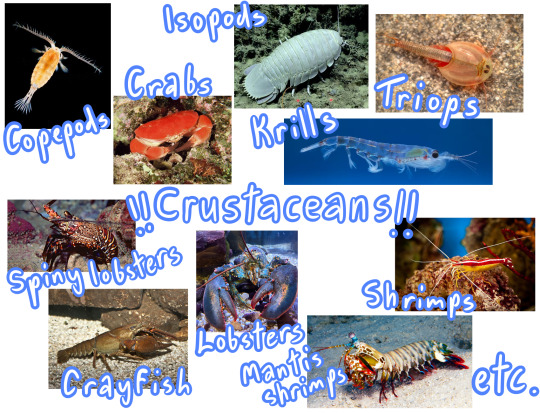
Many of our hard-shelled many-legged friends belong here! Crabs, lobsters, crayfish, shrimp, krill, isopods, triops, barnacles, copepods, you name it! Even though many crustaceans are aquatic or semiaquatic and have gills, you'll find that they're invertebrates that lack an internal skeleton (so no cranium, not even vertebrae)! We still love them though!
Mollusks (phylum Mollusca)

Creatures both soft and hard-shelled! Cephalopods like octopuses, squid, nautilus and cuttlefish, bivalves like clams, mussels, oysters or scallops, gastropods like sea slugs and snails and chitons go here! These friends of ours are also aquatic and have gills, some even have the suffix -fish (cephalopods used to be called inkfish, even!), but their lack of an endoskeleton is even more obvious than the crustaceans'. They're invertebrates, and therefore not fish!
Chelicerates (subphylum Chelicerata)
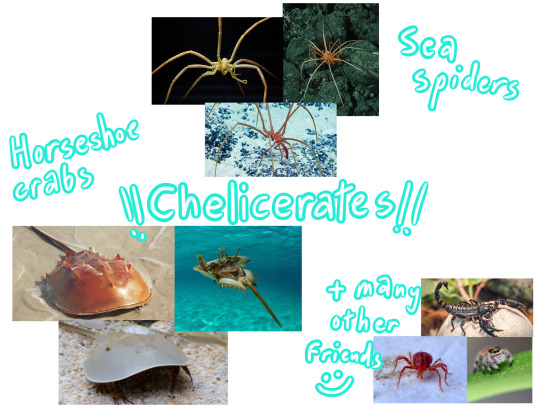
This group has many animals that are very hard to mistake for fish, namely spiders and scorpions, but horseshoe crabs and sea spiders are two groups of extant marine chelicerates! Both groups are aquatic, and horseshoe crabs have gills. However, they're both invertebrates, lacking a cranium or vertebrae. Other aquatic chelicerates exist, but they're usually very small, like water mites.
Cnidarians (phylum Cnidaria)

This phylum has the sessile corals and sea anemones and the usually more mobile jellyfish and siphonophores (includes the infamous Portugese man o' war!). I imagine corals and sea anemones are mistaken for fish less due to their sessile nature, but they're good to bring up nevertheless. None of these animals have a backbone, or, any bones really. They lack gills, they lack fins, they even lack the bilateral shape of fish. Jellyfish, despite the name, are indeed not fish! Some people suggest the name sea jellies be used for them instead, and I think it's much cuter.
Echinoderms (phylum Echinodermata)

Animals like starfish, sea urchins, brittle stars, sand dollars, sea cucumbers and feather stars go here. It seems that this pesky "-fish" -suffix is hard to shake off, as now we have the starfish. Once again, all of these slow-moving bottom-dwelling friends of ours are invertebrates, as they lack vertebrae or a cranium. Interestingly though, they are among our closest invertebrate relatives! So we ought to give them some props for that. I also want to mention that starfish can also be called sea stars, which ought to lessen confusion about their being too.
Comb jellies (phylum Ctenophora)

Comb jellies look a lot like jellyfish, but they belong in their own unique phylum! They have the same deal going on; they are invertebrates, they lack gills, they lack a cranium, they are simply aquatic.
Lancelets (subphylum Cephalocordata) and tunicates (subphylum Tunicata)
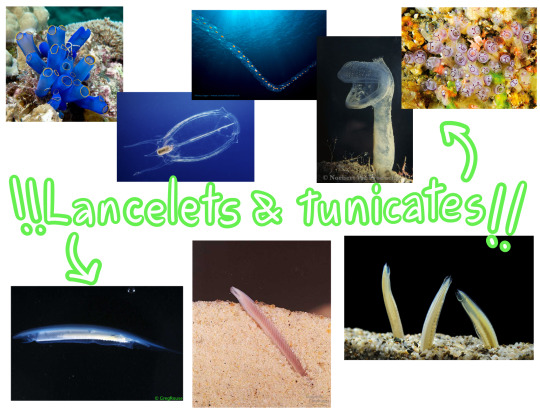
A double feature, because I wanted to save space didn't want these guys to be all alone! Lancelets and Tunicates, like sea squirts and salps, are chordates, which you can find in the phylogenic tree I drew all the way in the definitions section. They share many a feature with vertebrates, like a bilateral bodyplan, a notochord at some stage of life and a post-anal tail, but I'm afraid they're still not fish. They lack a cranium and their notochord does not develop into a vertebral column! Sorry friends, you tried. We can still hang out at the chordate convention.
Annelids (phylum Annelida)

The infamous bobbit worm, bone-eating worms, sea mice, giant tube worms, feather duster worms, spoon worms, bristleworms in general, leeches... many, many worms go here! Pretty self-explanatory: they are invertebrates, even when they live in water. They're extremely cool invertebrates too! I suggest taking a look at some of them, there's many interesting species.
Flatworms (phylum Platyhelminthes)

Flatworms are another very diverse group of worms, having many species both terrestrial and aquatic, however mostly I want to put attention into the free-swimming marine flatworms. They may swim beautifully (and fence with grace), but they are nevertheless invertebrates! Flatworms can live a variety of different lifestyles, from predators to parasites.
Amphibians (class Amphibia)

We've made it into vertebrates now! Amphibians include frogs, salamanders, and caecilians. While they have limbs with digits in their adulthood*, they can be easily confused for fish in their larval stages! This is no surprise, as they use gills to breathe underwater and tadpoles lack any limbs at all for a while. Many amphibians later transition into a terrestrial or semiaquatic way of life and lose their gills, not to mention gain their digit-having limbs.
(*excluding caecilians)
...Well, many amphibians do this, but not all. It's important to mention there are also species of aquatic salamanders which can bear great resemblance to fish with their elongated bodies! Amphiumas, which are sometimes mistakenly called "conger eels" (which is an actual species of fish), are aquatic salamanders with small residual limbs and both working gills and lungs. Giant salamanders and mudpuppies/waterdogs have lungs and gills as well, and lead an aquatic lifestyle — olms are close relatives of mudpuppies. Sirens, meanwhile, lack hind limbs and only have small front limbs, along with retaining their gills in adulthood. Among aquatic salamanders I also want to bring up one most often talked about species: the axolotl! They remain in their larval form, have external gills and lead an aquatic lifestyle. It can be hard to tell with aquatic salamanders sometimes, but these friends of ours are amphibians and not fish, even if they've rejected the land life.
Caecilians are a bit less known overall, but they can also cause a lot of confusion due to their long, limbless body. While most caecilians live underground, some are aquatic in nature, and can therefore be mistaken for fish! However, caecilians breathe via the use of their lungs and through the skin and don't have any gills at all.
Reptiles (class Reptilia)

Most commonly mistaken for fish in this group are sea snakes, sea kraits and water snakes, sea turtles, turtles, penguins, and other (semi)aquatic birds. Sea snakes and water snakes bear a very strong resemblance to eels, but they are indeed just snakes adapted to an aquatic or a semiaquatic lifestyle! The same goes for sea turtles, turtles overall, and penguins. They all need to breathe air and they lack fins, even if their flippers, webbed feet and built-in paddles may look like fins! They also have wholly different types of scales (or feathers!!) than what fish have, even if they share the feature. I assume that other aquatic reptiles, like the marine iguana and crocodilians are better read as reptiles thanks to their limbs with digits, but I want to give them a reptile shoutout anyway. They’re aquatic or semiaquatic, but they are air-breathers and fin-lackers all the same!
I also want to mention one specific extinct group of reptiles, ichtyosaurs! These marine reptiles were rather shark- or dolphin-like in appearance, which is actually a really good example of convergent evolution! Like all other reptiles, they also needed to breathe air and they had... erm... well, I'm not sure if I can call the bones in their flippers digits, but, that's what they used to be, so...? They were cool reptiles and among my favourites! There were many other aquatic reptiles too, but I will only mention just the ones now. A paleontology account would be better-suited to list you allll the marine reptiles.
Mammals (class Mammalia)

Our home class! Some of the aquatic friends we have in this class include whales like baleen and beaked whales, dolphins (orcas go here), porpoises, belugas, narwhals and sperm whales, pinnipeds like seals, sea lions, walruses, and sirenians like manatees, (occasionally known as sea cows) and dugongs! We also have some semiaquatic buddies like hippopotamids, otters, beavers and platypuses! Whales and pinnipeds especially often cause a lot of confusion due to their very streamlined, fishy appearance. They are, however, air breathers that feed their young with milk (some dolphin calves are even born with some hair), and their ancestors were land mammals! The same goes for pinnipeds and sirenians too. True seals, fur seals and sea lions still have fur even! Hippos, otters, beavers and platypuses are a bit more obvious as mammals with their fur and.. distinct air-breathing.. but I wanted to mention them anyway. Their adaptations to aquatic life are just one example of how fascinating evolution can be!
And here we are! A hopefully comprehensive list of fishes and non-fishes, beginning with the ever-shifting story of the term "fish", phylogeny, and why some animals are called fish when they really aren't. I hope you have found useful and interesting information in this post, and perhaps learned something new! I bid you a farewell! :D
#fish guide#fish essay#fish#fish facts#fishfact#marine biology#biology#zoology#long post#jawless fish#cartilaginous fish#ray-finned fish#lobe-finned fish
255 notes
·
View notes
Text

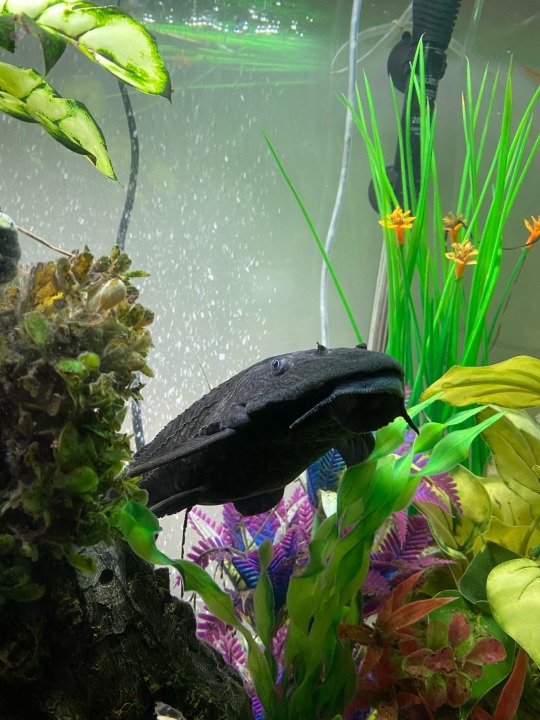

anyone else have a pleco that just naps in the weirdest places
#why sir#you can go anywhere in the tank but you choose here#fishblr#aquablr#my fish#pleco#freshwater#freshwater tank#plecostomus#funky pleco
16 notes
·
View notes
Text

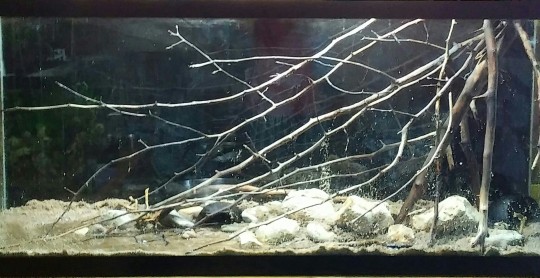
new 55 gallon scape yeehaw
#i used hawthorn branches from my backyard bc buying driftwood?? in this economy??#and all the plants are HOPEFULLY herbivorous cichlid-proof#just some anubias and java fern#i originally had this tank set up for guppies#then the heater in my quarantine tank decided to die only a few days into the qt#for these. pet store guppies. you see where this is going#put the quarantined guppies right into the 55gal and what do you know. they had columnaris and the entire tank was wiped out#so this is try no. 2 on the 55 gal#to my own shock and befuddlement this pandemic hasnt wiped my asthma ridden lungs out yet! but im an ~essential worker~ so my schedule is...#how you say....... fucked#ill try to be less inactive on here when i can#personal#fishblr#aquablr#mine#rainbows and swords
106 notes
·
View notes
Photo
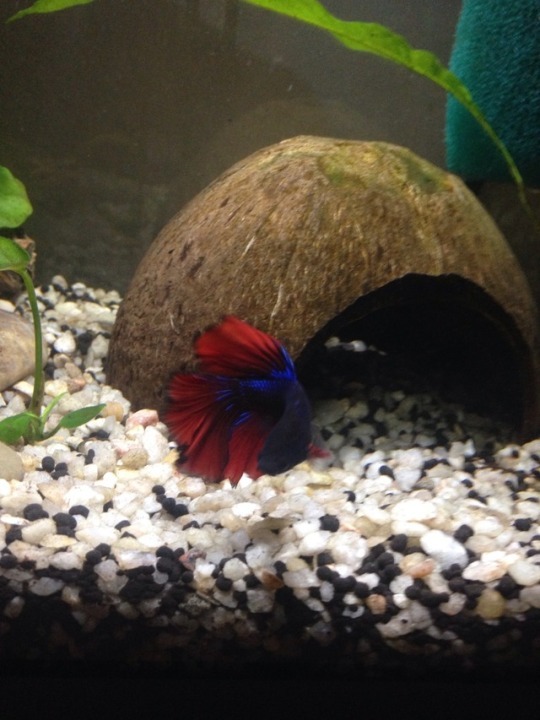

Oh no...I’m in love.
His name is Raymond and he’s perfect. Already so angry and inquisitive about everything, and look at those COLORS...
#shin speaks#bettablr#fishblr#welp#i went to my closest lfs for plants and came home with a new son#he's seriously so gorgeous though i can't get over it#he was also in a really crowded tank with a bunch of neons and otocinclus#so now he's like all this space?? for me???#i might get him some ember tetras or something eventually since I know he's okay with tankmates but for now#yes#all that space is just for you#and gayle of course but he seems to be leaving it alone#so that's a good sign#ignore me#this message will self destruct#i should probably make a sideblog for all my fish rambling I get the feeling it's just going to get more frequent from here#for anybody who's interested he is taking over bodhi's old instagram tho#@ray_the_betta
8 notes
·
View notes
Text
I have not only one of those ziss bubbly things coming my way next week, but also my brand new shiny ultra German
EHEIM
goddamnit i missed canister filters so much and after my brother dropped and broke the last one I knew it was my chance to finally get my hands on one of these fuckin filters that has eluded me for so damn long it’s been driving me nuts
honestly the ziss thing was just out of curiosity because nobody who has one will shut up about it so based on my Repashy findings this I too must try to see if it’s a better secondary than a plain ol’ £5 sponge on a straw thing
i just love buying new things for the aquariums, it’s by far the best part of setting up a new tank aside from seeing the finished article
#fishblr#my new tank will be here soon can you tell#i'm actually more excited about this bloody filter than i was about Christmas jfc#plus i have all my sand and lovely river rocks ready to go and am IMPATIENT#I WANT TO AQUASCAPE DAMMNIT
3 notes
·
View notes
Text
Everything I’ve read has said Flowerhorns should be kept alone because they are very aggressive. Is keeping a bichir with one really a good idea?
I mean, because if so, that will be my long term plan for the huge tank I want to build. Because Flowerhorns are such quirky and cute fish. But my research suggested that was a bad idea...
#fishblr#king of diy#the king of diy#my current plan is a few small bichir and one oscar#more than one oscar if that would be safe#but i've heard mixed opinions#i saw a flowerhorn that was super friendly the other day#just like Frank#so i mean if i could get one that would be great#but i can't afford to have a tank dedicated to a flowerhorn when i have a few other large fish i want#and a flowerhorn isn't a priority#the bichirs are#and then oscar next to that#and i'd say a flowerhorn is 3rd down#so yeah if it isn't safe to keep them with oscars or bichirs the flowerhorn is a no go here#and that's fine#i've learned that you have to learn to compromise for the good of the animals in fishkeeping#because it is better that you compromise than make the animals do it to the detrimentof their well being#i feel like the king of diy isn't thinking about that
1 note
·
View note
Text
While I generally don’t just make a post in order to Promote a Brand, for those of you who are here for my aquatics posts/are interested in starting or adding to your planted tanks, can I just say that BucePlant is literally the best site to buy aquarium plants/hardscape supplies/miscellaneous aquarium stuff from?
I really (REALLY) love having lots of different kinds of bucephelandra in my tanks because it’s basically the perfect plant for any type of freshwater aquarium, but good lord is it expensive... for good reason, it’s new-ish to the hobby and it takes a long long time to grow. That said, BucePlant’s prices for the quantity and quality of the buce (and every other plant) they sell are incredible, the site is super easy to navigate and has accurate and genuinely helpful care information for every single kind of plant they sell, and I’ve never gotten anything from them that was anywhere near unhealthy or introduced pests/new forms of algae into my tanks. Their product is just fantastic and my experience with the site has always been excellent.
Anyway, the reason I’m going all in on recommending them now is how great they’ve been with an issue with an order that was totally out of either of our hands: I ordered a bunch of plants in February before the snow/cold hit Texas and surrounding environs, BucePlant sent them out to me (which meant shipping them from California to New York) ...and then, the storm hit and my package got stuck in transit for literally a month. When I finally got it yesterday, almost all the plants I ordered had died due to the cold/shipping delay.
I had no idea if they’d do anything, given the circumstances, but I emailed their customer support last night to tell them what happened, and a customer service rep responded this morning to advise that they’d be sending me replacements for everything that died, which is, needless to say, amazing - I’d been so stoked to give the puffers some more plants to explore in, so it was a huge bummer when I realized the chances of any of my buce or bolbitis surviving the shipping delay were practically nonexistent.
Anyway, for any of you who are here for my fishblr posts, big recommendation - I can’t wait to post pics of the additions to the pea puff tank once they arrive!
38 notes
·
View notes
Text
Fishblr game: Name a little-known aquarium fish!
Reblog with a fish that doesn't seem to be well known in the trade, but whose needs could be appropriately met in a home aquarium. Maybe you’ll introduce someone to their new favorite species!
(Preferably species that can be, at least rarely, purchased.)
Try to do one you don't already see in the notes!
I'll start:

"Dwarf Golden Barb", Pethia gelius
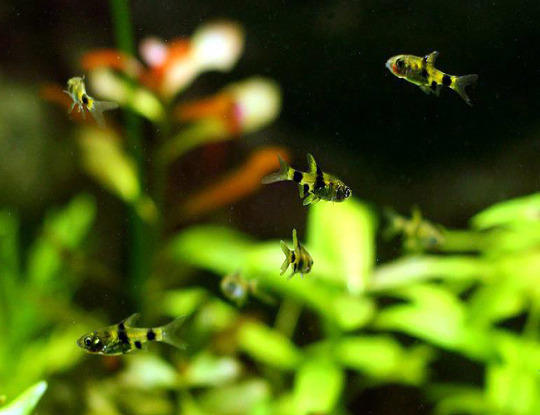
(Bet you thought I'd do a catfish, eh? These are actually pretty high on my non-catfish wishlist, though. One day I'll have a compatible setup or maybe just a species tank in a future fish room...)
[Images pulled from google search. Link to source for first image. Link to source for second image.]
#i just found this in my drafts#i thought tumblr ate it#fishblr#look at me being social again#fun fact im horribly shy and bad at people#thats why i often sound like a robot on here#oops#also fun fact i dont initiate conversations so ill sit over here thinking youre really cool but i will never talk to you#unless maybe thats already happened for some reason#but no way in hell am i going first#this has nothing to do with this post and its designed to be passed around the community i should probably stop#oops again
18 notes
·
View notes
Text
It’s not bad husbandry or laziness if you have algae in your tank or water spots on the glass. Try finding a place for a 240l tank in a room with four windows that doesn’t get direct sunlight. Impossible if you’re also worried about statics. So algae is kinda unavoidable in some cases.
But algae does not harm your fish or other aquatic animals. My minnows even like to breed in the hair algae... It might be about an imbalance in your tank (light in most cases i believe) but that’s not necessarily harmful.
I understand that there are different ways of the hobby and many people like to focus on aesthetics and such which is not a bad thing per se. But please remember that for a lot of people keeping fish is about building a home for the fish that caters to the animals needs, not the needs of the fish keeper.
Plus it’s a dick move to tell a bunch of mentally ill kids on the internet that they are lazy or not taking proper care of their fish if they don’t clean the glass of their tank or have an algae problem.
#fish#fishblr#i might be late to this i had my exams the last two days#but this topic is bothering me#i believe there is too much cleaning going on in a lot of fishblr tanks#please consider that your 'deep cleans' are also stressful for the fish especially if you have to take your fish out of the tank#and lets face it fishblr is mostly a bunch of mentally ill kids i'm one of the old ones here#i don't mean to excuse actual bad husbandry with mental illness#but we are talking about a bit of algae here
1 note
·
View note
Text
I know I haven't posted here much lately but I know you have all heard about the snowstorm in Texas and I've had massive casualties. It's been nearly two days without power and I've lost all the tropical fish. My betta, Torra, my puffer Bea, all my pygmy cories and rasboras have passed... Both of the axolotls are okay for now but it's going to be another hard freeze tonight so if anyone left in the fishblr community could send positive vibes or prayers that they survive this I would be beyond grateful. Love you guys stay safe stay warm
8 notes
·
View notes
Text
Taking Down Some Abusive Viral Fish Videos
Tw: fish abuse

Ok, so I haven't been on here since 2017, but I've come across something that could use the help of fishblr. There's a YouTube channel called The Animals Around Us. This channel is the source of the video from the meme I screenshotted. They seem to be a breeder of some sort? They also run a slime channel.
They've been posting videos of fish being poured into buckets. These videos get millions of views. The problem is, the lack of attention paid to things like fish compatibility . In some videos, multiple male bettas are placed in one bucket, with many other fish and sometimes an axolotl. There's plenty more wrong there, but I'd say that's the most obvious reportable offense. It's widely known that male bettas will try to kill each other if put together.
What I'm asking is, please report these Youtube videos, using the male bettas as the reasoning. I don't wanna see "satisfying" fish videos like these become a trend. They're dangerous to the animals involved and are a source of misinformation. They further the misconception that you can just keep any random combination of cute fish in a tank together.
Thanks for reading and sorry for the bummer of a post.
PS: These days I've been focused on art and I'm doing really well! I've still got my pond going with lots of happy goldfish.
4 notes
·
View notes
Text


Olive finished his treatment today. We did two weeks of kanaplex x metroplex with daily 100% water changes and daily epsom salt baths. If you havent seen any of my earlier posts, he was pineconing after going back and forth with popeye for a few weeks.
Now that his treatment is over, his scales are down but his eye is worse than ever. I’ve set up his quarantine with a filter, and tossed one of my plants in there. He’s going to be in here a while and I want him to a be a little bit more comfortable (I’m not really interested in doing 100% changes every day anymore either.)
I guess we’ll see how he does.
p.s. the dates are still on there from back when marmalde first got sick. if you’ve been following me since back when fishblr was cool, you might remember.
#fishblr#olive#sick fish#dropsy#pineconing#quarantine fish#mine6741#popeye#goldfish#black moor#fancy goldfish
12 notes
·
View notes